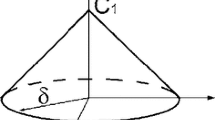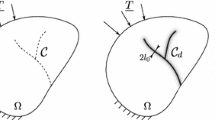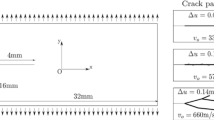Abstract
In this paper we discuss the peridynamic analysis of dynamic crack branching in brittle materials and show results of convergence studies under uniform grid refinement (m-convergence) and under decreasing the peridynamic horizon (δ-convergence). Comparisons with experimentally obtained values are made for the crack-tip propagation speed with three different peridynamic horizons. We also analyze the influence of the particular shape of the micro-modulus function and of different materials (Duran 50 glass and soda-lime glass) on the crack propagation behavior. We show that the peridynamic solution for this problem captures all the main features, observed experimentally, of dynamic crack propagation and branching, as well as it obtains crack propagation speeds that compare well, qualitatively and quantitatively, with experimental results published in the literature. The branching patterns also correlate remarkably well with tests published in the literature that show several branching levels at higher stress levels reached when the initial notch starts propagating. We notice the strong influence reflecting stress waves from the boundaries have on the shape and structure of the crack paths in dynamic fracture. All these computational solutions are obtained by using the minimum amount of input information: density, elastic stiffness, and constant fracture energy. No special criteria for crack propagation, crack curving, or crack branching are used: dynamic crack propagation is obtained here as part of the solution. We conclude that peridynamics is a reliable formulation for modeling dynamic crack propagation.
Similar content being viewed by others
References
Belytschko T, Chen H, Xu J, Zi G (2003) Dynamic crack propagation based on loss of hyperbolicity and a new discontinuous enrichment. Int J Numer Methods Eng 58: 1873–1905
Bobaru F, Yang M, Alves LF, Silling SA, Askari E, Xu J (2009) Convergence, adaptive refinement, and scaling in 1D peridynamics. Int J Numer Methods Eng 77: 852–877
Bolander JE Jr., Saito S (1998) Fracture analyses using spring networks with random geometry. Eng Fract Mech 61: 569–591
Bowden FP, Brunton JH, Field JE, Heyes AD (1967) Controlled fracture of brittle solids and interruption of electrical current. Nature 216: 38–42
Buehler MJ, Abraham FF, Gao H (2003) Hyperelasticity governs dynamic fracture at a critical length scale. Nature 426: 141–146
Camacho GT, Ortiz M (1996) Computational modelling of impact damage in brittle materials. Int J Solids Struct 33: 2899–2938
Cox BN, Gao H, Gross D, Rittel D (2005) Review: modern topics and challenges in dynamic fracture. J Mech Phys Solids 53: 565–596
Döll W (1975) Investigations of the crack branching energy. Int J Fract 11: 184–186
Field JE (1971) Brittle fracture: its study and application. Contemp Phys 12(1): 1–31
Graff KF (1975) Wave motion in elastic solids. Dover, New York
Ha YD, Bobaru F (2009) Traction boundary conditions in peridynamics: a convergence study. Technical report Department of Engineering Mechanics, University of Nebraska–Lincoln, Lincoln, Nebraska
Ha YD, Bobaru F (2010) The effect of damage-dependent fracture energy on symmetry-breaking in dynamic brittle fracture. Technical report, Department of Engineering Mechanics, University of Nebraska–Lincoln, Lincoln, Nebraska.
Ha YD, Bobaru F, Parks ML (2010) Dynamic brittle fracture: crack branching predictions with peridynamics (submitted)
Hairer E, Lubich C, Wanner G (2003) Geometric numerical integration illustrated by the Störmer/Verlet method. Acta Numer, 1–51
Livne A, Ben-David O, Fineberg J (2007) Oscillations in rapid fracture. Phys Rev Lett 98(12): 124301
Ortiz M, Pandolfi A (1999) Finite-deformation irreversible cohesive elements for three-dimensional crack-propagation analysis. Int J Numer Methods Eng 44: 1267–1282
Rabczuk T, Belytschko T (2004) Cracking particles: a simplified meshfree method for arbitrary evolving cracks. Int J Numer Methods Eng 61: 2316–2343
Ramulu M, Kobayashi AS (1985) Mechanics of crack curving and branching—a dynamic fracture analysis. Int J Fract 27: 187–201
Ravi-Chandar K (1998) Dynamic fracture of nominally brittle materials. Int J Fract 90: 83–102
Ravi-Chandar K, Knauss WG (1984a) An experimental investigation into dynamic fracture: III. On steady-state crack propagation and crack branching. Int J Fract 26: 141–154
Ravi-Chandar K, Knauss WG (1984b) An experimental investigation into dynamic fracture: IV. On the interaction of stress waves with propagating cracks. Int J Fract 26: 189–200
Silling SA (2000) Reformulation of elasticity theory for discontinuities and long-range forces. J Mech Phys Solids 48: 175–209
Silling SA (2005) Fragmentation modeling with EMU. Technical report, Computational Physics Department, Sandia National Laboratories, Albuquerque, New Mexico
Silling SA, Askari E (2005) A meshfree method based on the peridynamic model of solid mechanics. Comput Struct 83: 1526–2535
Silling SA, Demmie P, Warren TL (2007a) Peridynamic simulation of high-rate material failure, 2007 ASME applied mechanics and materials conference, Austin, TX, June 6
Silling SA, Epton M, Weckner O, Xu J, Askari E (2007b) Peridynamic states and constitutive modeling. J Elast 88: 151–184
Silling SA, Lehoucq RB (2008) Convergence of peridynamics to classical elasticity theory. J Elast 93: 13–37
Silling SA, Weckner O, Askari E, Bobaru F (2009) Crack nucleation in a peridynamic solid. Int J Fract (this issue)
Song J, Areias PMA, Belytschko T (2006) A method for dynamic crack and shear band propagation with phantom nodes. Int J Numer Methods Eng 67: 868–893
Song JH, Wang H, Belytschko T (2008) A comparative study on finite element methods for dynamic fracture. Comput Mech 42: 239–250
Streit R, Finnie I (1980) An experimental investigation of crack-path directional stability. Exp Mech 20: 17–23
Xie W (2005) Peridynamic flux-corrected transport algorithm for shock wave studies. Master thesis, Department of Engineering Mechanics, University of Nebraska–Lincoln, Lincoln, Nebraska
Xu XP, Needleman A (1994) Numerical simulations of fast crack growth in brittle solids. J Mech Phys Solids 42: 1397–1434
Zhou F, Molinari JF (2004) Dynamic crack propagation with cohesive elements: a methodology to address mesh dependency. Int J Numer Methods Eng 59: 1–24
Zhou SJ, Lomdahl PS, Thomson R, Holian BL (1996) Dynamic crack processes via molecular dynamics. Phys Rev Lett 76(13): 2318–2321
Author information
Authors and Affiliations
Corresponding author
Rights and permissions
About this article
Cite this article
Ha, Y.D., Bobaru, F. Studies of dynamic crack propagation and crack branching with peridynamics. Int J Fract 162, 229–244 (2010). https://doi.org/10.1007/s10704-010-9442-4
Received:
Accepted:
Published:
Issue Date:
DOI: https://doi.org/10.1007/s10704-010-9442-4




